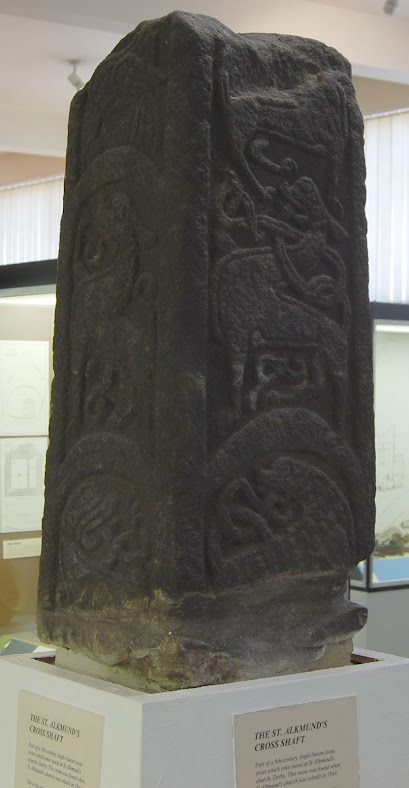St Alkmund
Alkmund (774 - around March 19th, c. 800) was a prince from Northumbria, the younger son of King Ahlred (also known as Alcred), and the brother of Osred. This era was marked by intense conflicts and political scheming among contenders for the throne. Many of these contenders met grim fates, making it a perilous time for members of the Northumbrian royal family. They faced threats not only from Viking raiders who had started to carry out significant attacks along the coast but also from their own relatives.
Exiled among the Picts at a tender age, Alkmund, accompanied by his father, eventually returned to his homeland, leading an army. Tragically, he fell victim to treachery, and the blame for his demise has often been placed on the usurper Eardwulf. His remains were laid to rest in Derby, where he swiftly gained veneration as a Saint, with his feast day designated as March 19th, marking the anniversary of his death.
While Alkmund's 'good deeds,' whether factual or legendary, might have otherwise faded into obscurity among the many lesser-known Saxon saints, his legacy endured, largely due to the support of his descendant, Aethelfleda, renowned as the great 'Lady of the Mercians.' Aethelfleda, the eldest daughter of Alfred the Great, inherited the rule of Mercia after the death of her husband, Aethelred, in 911—an extraordinary position for a woman during those times. A capable ruler, Aethelfleda's decision to establish a new and prosperous church dedicated to Alkmund in Shrewsbury (founded around 912) was motivated by practical concerns, including the lack of security from heathen raiders further east. However, there is no concrete evidence to suggest that the relics of St. Alkmund ever reached this far west. In the mid-12th century, Lilleshall Abbey assumed ownership of a substantial portion of the wealth and assets of the Shrewsbury church. It was during this period that the relics of St. Alkmund found their way to Lilleshall, eventually marking their return to Derby. The movement of relics, even including the remains of saints, was a far more frequent occurrence than one might envision during this era.
While Lilleshall experienced this transfer, it ultimately benefitted Derby, as the influx of pilgrims brought both prosperity and a degree of renown to the city. Notably, two of the six churches dedicated to Alkmund's name are located in Derby, with the other two in Shropshire (including one in Whitchurch within the same county).
This stone hogback grave marker, originally from St. Alkmund's Church in Derby, is believed to have occupied one of the oldest Christian sites in the region. Archaeological excavations on this site have revealed the church's existence prior to the ninth century. However, the arrival of the Great Army in the ninth century appears to have triggered a phase of neglect and deterioration. It was subsequently restored following the reconquest of the Danelaw in the tenth or early eleventh century.
Only a fragment of this hogback grave cover remains intact. It features the characteristic bear figure at the gable end, albeit with some damage to the carving, and an interlaced serpent design within the panels on the sides. Such grave covers are a common find throughout northern England and extending into Scotland. They are typically discovered in regions dominated by Viking influence and seem to represent an Anglo-Scandinavian tradition that combines elements of both pre-Christian and Christian iconography.
The beautifully decorated stone sarcophagus had been buried so that the lid would have been level with the twelfth century ground surface. However the elaborate decoration on all four sides shows that it was intended to be seen. Its position “on the floor of the sanctuary” is the same as Bede’s description of the enshrinement of St. Cuthbert and that of the relics of St. Oswald which were eventually placed in the eastern portico of the priory of St Oswald, Gloucester. Evidently this had been a burial of considerable importance, the date and position of which almost certainly identify it as the shrine of Saint Alkmund.
The museum's exhibit label says "Part of 9th-century Anglo Saxon stone cross which once stood at St. Alkmund's church, Derby. This stone was found when St Alkmund's church was rebuilt in 1844. The cross was originally about 4 metres tall. There are birds and beasts carved on all four sides."
The little we know about Saint Alkmund (or Ealhmund) comes from the late twelfth-century chronicle attributed to Simeon of Durham that seems to draw on a set of York annals 703-802.
Some further confusing details are given by Ranulf Higden, a fourteenth century monk of Chester, in his Polychronicon. His account, thought to be drawing on an earlier Vita of St. Alkmund, states that Alkmund was killed in battle at Kempsford (on Thames, near Cricklade) and that his body was first buried in the Album Monasterium (White Monastery) which usually is supposed to mean Lilleshall. This late medieval account is problematical because it states that Alkmund was involved in a battle so far from his native Northumbria. This is further compounded by the fact that the Anglo-Saxon Chronicle record of the battle at Kempsford makes no mention of Alkmund. The initial burial at Lilleshall seems to be inaccurate because the abbey at Lilleshall was not founded or built until after the Norman Conquest: the Domesday survey lists only a church there. However, Domesday does inform us that Lilleshall was one of a dozen or so manors held by the royal foundation of St. Alkmund’s Shrewsbury.
For more about St Alkmund and his well, along with miracles, check out the post on the Saxons here: Saxon Settlers (derbyheritage.blogspot.com)




